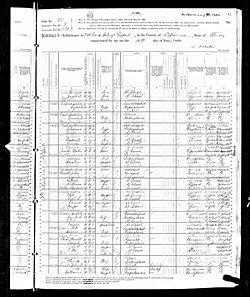
Enumeration is the act or process of counting something or making a count of something. It can also refer to the act of reciting numbers or creating a numbered list. In various contexts, enumeration has been used for different purposes, such as in history, genealogy, and data management. This article will explore the concept of enumeration, its historical background, and its connection to family history research and relevant historical records.
Enumeration refers to the act of counting or listing items in a systematic manner. It can involve counting or reciting numbers, creating a numbered list, or organizing data into specific categories. Enumeration is often used in various fields, including history, genealogy, and data management, to organize and analyze information.
Enumeration in U.S. historyEnumeration in U.S. history
In the United States, enumeration has played a significant role in the country's history, particularly in the context of the U.S. Constitution. The Enumeration Clause, found in Article 1, Section 2 of the Constitution, requires a count of the population in each state every ten years for the purpose of apportioning representatives[1]. This process, known as the U.S. Census, has been conducted every decade since 1790 and has evolved over time to include more detailed information about the population.
Enumeration procedures in census takingEnumeration procedures in census taking
The process of enumeration in census-taking has undergone several changes throughout history. In the early days of the U.S. Census, enumerators were responsible for visiting households within their assigned districts and recording information about the inhabitants. These districts, known as enumeration districts, were created to ensure that the territory could be covered quickly and efficiently[2].
As the U.S. population grew, the need for a more organized system of enumeration became apparent. In 1880, the Census Bureau introduced the concept of enumeration districts to make the process more manageable[3]. These districts were geographically defined areas, with rural districts being larger in size and urban districts being smaller. Enumerators were expected to be residents of the districts they canvassed and be familiar with the area and its inhabitants[4].
Over time, the enumeration process has become more sophisticated, with the introduction of new technologies and methods for collecting and analyzing data. Today, the U.S. Census Bureau uses a combination of mail, telephone, and online surveys to gather information about the population.
Enumeration and family history researchEnumeration and family history research
Enumeration plays a crucial role in family history research, as it helps genealogists trace their ancestors and uncover valuable information about their lives. Census records, in particular, are invaluable tools in genealogical research, as they provide detailed information about individuals and families that can help make connections across generations[5].
Enumeration in census recordsEnumeration in census records

Census records are among the most important sources of information for genealogists, as they provide a wealth of data about individuals and families. These records typically include basic personal facts for each respondent, such as name, age, sex, race, and place of birth. In addition, census records often contain information about an individual's occupation, education, marital status, and other details that can help paint a picture of their life.
Census records can also provide insights into the social and economic conditions of a particular time and place, making them valuable resources for understanding the broader context of an ancestor's life. For example, census records may reveal information about local industries, patterns of migration, and changes in population demographics.
Enumeration in historical recordsEnumeration in historical records
In addition to census records, enumeration can be found in various other historical records that are relevant to family history research. Some examples include:
- Church records: In the American colonies, ministers, sextons, and elders kept church records that provided demographic information about the congregation[6].
- Maps and cartographic records: Maps can provide important information on place names and geographic features, which can be useful in tracing the movements of ancestors[7].
- Primary sources: Diaries, family letters, interviews, oral histories, family photographs, newspaper articles, government documents, and other primary sources can provide valuable insights into the lives of individuals and families[8].
See alsoSee also
Explore more about enumeration and censusesExplore more about enumeration and censuses
- Census records on MyHeritage
- MyHeritage's U.S. Census Hub
- How to Search U.S. Census Records on MyHeritage, how-to video on the MyHeritage Knowledge Base
- The U.S. Census: Tracing Your Family in Census Records, article by Daniel Horowitz on the MyHeritage Knowledge Base
References
- ↑ Answer to "What does enumeration mean in US history?", provided in the context.
- ↑ Passage from "History of Enumeration Procedures, 1790-19401", provided in the context.
- ↑ Passage from "What is an Enumeration District on the Census?", provided in the context.
- ↑ Passage from "History of Enumeration Procedures, 1790-19401", provided in the context.
- ↑ Answer to "How do census records help with genealogy?", provided in the context.
- ↑ Passage from "The Great Enumeration", provided in the context.
- ↑ Passage from "Maps at NARA of interest to Genealogists", provided in the context.
- ↑ Passage from "History: Primary & Secondary Sources - Library Guides", provided in the context.
Explore more about enumerationExplore more about enumeration
- History of Enumeration Procedures, 1790-1940 at IPUMS USA
- The Great Enumeration at American Heritage
- Maps at NARA of interest to Genealogists at National Archives
- Genealogy FAQs at United States Census Bureau
- History: Primary & Secondary Sources at W Library
- What is an Enumeration District on the Census? at Name Census

